The Gift of South Dakota
Subscriptions to South Dakota Magazine make great gifts!
Subscribe today — 1 year (6 issues) is just $29!
Milkweed Champs
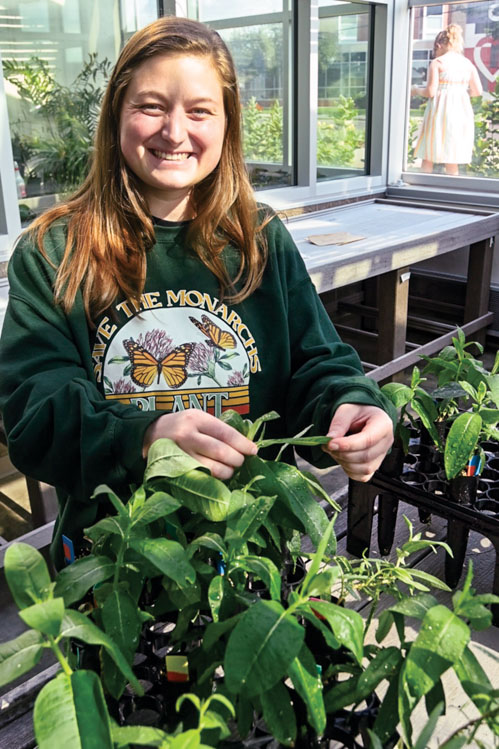 |
| Sydney Kreutzmann, a biology technician in the Olson-Manning Laboratory at Augustana University in Sioux Falls, leads experiments on the ability of South Dakota's milkweed species to absorb moisture. |
Woe is the ancient milkweed. South Dakotans have hoed, chopped, sprayed and cussed it for one hundred years.
Milkweed finally gained respect when nature-lovers learned that the flashy monarch butterfly nests only in it. But the butterfly chews on its leaves, defoliating the poor plant sometimes to the point of death. Where’s a milkweed to turn for love?
That would be Augustana University in Sioux Falls, where a team of young scientists and students are studying the intriguing plant.
“Whenever I’m wearing one of my milkweed t-shirts at the airport, someone always comes up to me and says that they love the milkweeds,” says Steven Matzner, an Augustana biology professor. “Usually it’s because they like the monarchs.”
He and Carrie Olson-Manning, an associate professor of biology, were looking for a local plant system to study in 2017 when she found a blurb in a Plants of the Prairie guidebook that said two major species of milkweed — the showy and the common — hybridize only along a strip of land that includes the very center of South Dakota.
“I ran down the hall and showed it to Steve,” she recalls. “Based on his knowledge of our state, he knew that the hybridization was around the 100th meridian.”
The two Augustana teachers and their students have been studying the plant ever since. Last year, Olson-Manning won a $1.2 million National Science Foundation award given to promising young scientists, so the milkweed project is ramping up.
South Dakota is the ideal place to study milkweeds because of the 100th meridian, the longitudinal line that is considered the border between the arid West and the more humid East. The invisible boundary crosses north-to-south in the very center of South Dakota.
Olson-Manning says there are 130 species of milkweed in North America, but two varieties cover much of the continental United States. Common milkweed (Asclepias syriaca) grows from the Atlantic Coast to the 100th meridian. Showy milkweed (Asclepias speciosa) grows from the Pacific Coast to the 100th meridian.
Neither species has encroached naturally past that boundary, and the two have not intermingled or hybridized anywhere else in the wild.
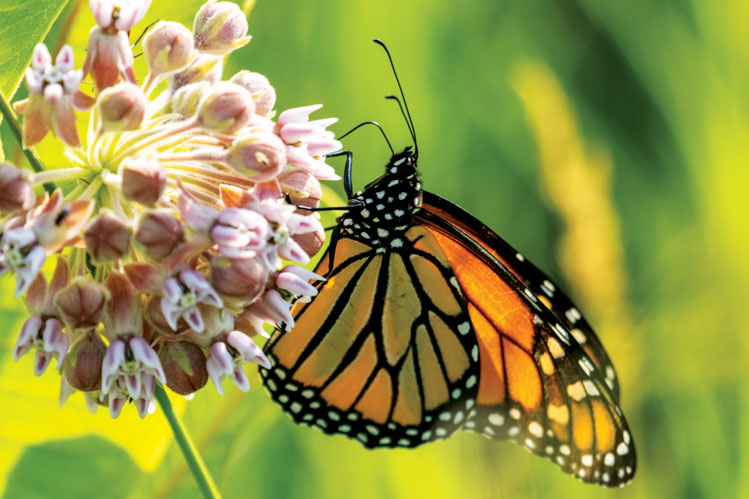 |
| Milkweed plants are crucial in the life cycle of monarch butterflies. Female monarchs lay their eggs only on milkweed leaves. |
Milkweeds are an ancient plant, possibly dating back 2 million years. The two Augustana colleagues believe that the species they are studying were likely separated during the Ice Age and then began to reconnect and hybridize sometime after the last glaciers melted about 10,000 years ago.
Why don’t the hybridized species grow beyond that swath along the 100th meridian? Why doesn’t the common milkweed grow west of it, and why doesn’t the showy grow to the east? What can we learn from the plants that might be useful to other plants or humans? And why are milkweed species disappearing from rural landscapes? Those are some of the questions being asked.
As the research project literally took root on the Augustana campus — where milkweeds are now nurtured near the front steps of the glass-and-brick Froiland Science Center and indoors in a sunny laboratory greenhouse — the public became aware that the eastern monarch butterfly is also in trouble.
The demise of the milkweed relates to the well-being of the monarch. Female monarchs lay their eggs only on milkweed leaves. The hatched larva eats on the leaves for about two weeks before the caterpillar forms a cocoon, or pupa.
In another 8 to 12 days, the pupa blossoms into the beautiful monarch, which then seeks nectar and thus serves a valuable purpose in farm country as a pollinator.
The monarch caterpillar absorbs a toxin from the milkweed that tastes bitter and can be poisonous to vertebrates. When it morphs into a butterfly, its colorful markings act as the opposite of camouflage. The orange and black signal “danger” to birds, snakes and rodents who might otherwise consider it a tasty treat.
Wildlife enthusiasts are enchanted by the monarch’s amazing annual migration from Canada and the northern United States to the Sierra Madre Mountains of central Mexico, 2,000 miles from South Dakota. It is the only butterfly that makes a two-way migration. Other species winter as larva or pupa, but monarchs cannot tolerate the cold Dakota winters.
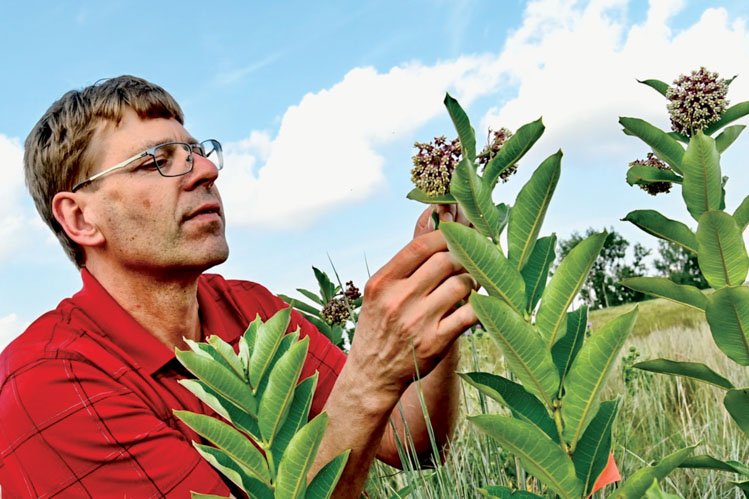 |
| Dr. Steven Matzner, like most farmers' sons, grew up believing milkweeds were to be chopped or sprayed to death. |
Increased use of pesticides and insecticides has severely damaged monarch and milkweed populations. Changing weather patterns have also had a negative effect.
Nobody seemed to care about the lowly milkweed until the monarch, its colorful pest, was reported to be in decline. Scientists say the monarch population has dwindled as much as 80 percent in the last 20 years.
Fascination for the intermingled species was apparent last August when faculty and student researchers from across the state met at the University of South Dakota campus in Vermillion for the annual BRIN (Biomedical Research Infrastructure Network) convocation.
Matzner spoke about Augustana’s milkweed project in a lecture hall with 25 young scientists who listened raptly about the plant’s peculiar hybridization habits. “They don’t move past each other,” he said, “but they seem to be stuck in a transition zone that seems to be several hundred miles wide.”
He explained that the hybridization extends throughout both Dakotas and southerly through Nebraska and Kansas. He noted that he and Olson-Manning are especially interested in how the common milkweed and the showy milkweed differ in their water-related traits.
The audience of teachers and students had many questions.
“Is there a difference in drought tolerance?”
Matzner said students at Augustana have weighed pots for months to measure the two plants’ ability to extract water. “We thought the showy milkweed would be more drought tolerant, but when we did the experiments the two species were similar. That left us with the question of how the showy milkweed lives in the drier part of the state when it is not more drought tolerant.”
He says part of the answer is that it is constrained to wet places within the drier western part of South Dakota; it avoids drought by growing where the land is wet.
Another audience member asked, “What is the role of the milkweed in the ecosystem?”
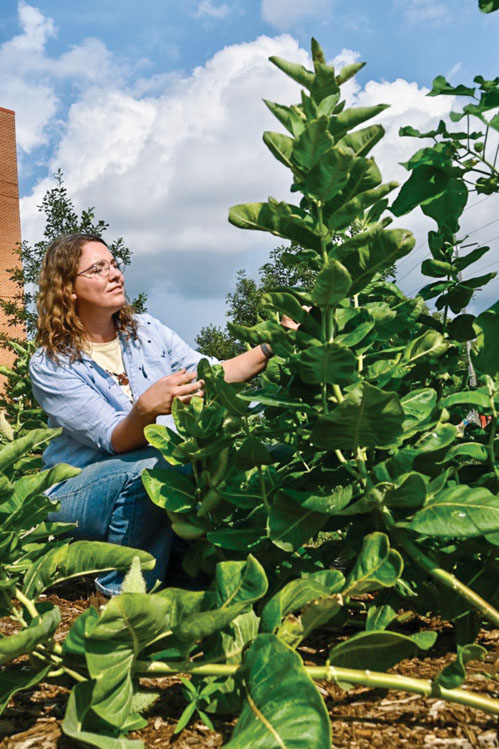 |
| Dr. Carrie Olson-Manning grows milkweed near the front steps of her Augustana University research lab. |
“So,” answered Matzner, “have you heard the phrase, ‘Nature abhors a vacuum?’ Milkweed is one of those species that is good at colonizing after a disturbance. Like when a river floods and creates bare ground. It is one of the weedy spaces that fills in the holes or gaps created by disturbances. Interestingly, many of our crop species also evolved from these same types of weedy plants. When humans started plowing the prairie, we likely increased the habitats available for plants like milkweed, and so farming was probably initially good for milkweed abundance. Ironically, we now have gotten so good at killing the ‘weeds’ that intensive agriculture has decreased milkweed abundance.”
“Do you have any contact with the monarch butterfly people?” asked a young teacher.
Matzner answered, “We have a lot of people who love monarchs who come by the fields.”
He noted that Olson-Manning knows many monarch scientists. She is planning experiments this summer with butterfly researchers. Together they’ll study how the caterpillars are able to survive and grow on the two milkweed species and their hybrids.
After the conference, Olson-Manning further explained that the Augustana team is now recruiting teachers to plant gardens in local schools, “so they can learn about climate change and biodiversity from this beautiful system.”
Matzner and Olson-Manning hope to convince 10 school districts to collaborate by planting milkweed gardens. “We are recruiting K-12 teachers to create curriculums around the two species — the monarchs and the milkweed. We’re leaving it up to the creativity of the teachers to decide what their projects should be,” she says. They expect that the teachers and students will participate for love of the monarch rather than the milkweed, but they’ve come to welcome the symbiosis.
The Augustana profs have already established large research gardens at the state Game, Fish and Parks’ Outdoor Campus sites in Rapid City and Sioux Falls. They also intend to start a garden at Custer in the southern Black Hills.
Never in South Dakota history has the lowly milkweed garnered so much love and attention, and Matzner and Olson-Manning are the perfect persons to lead the research.
Olson-Manning’s father was a northern Minnesota farmer who had an interest in native plants and mentored young agriculture students on the importance of working with nature. She remembers watching caterpillars and butterflies on milkweeds, picking pods and scattering their wispy fluff.
After her father died two years ago, she came across a picture he’d taken long ago of a milkweed on their farm. It now sits in her office at the Froiland Science Center.
Matzner also grew up on a farm. His father is retired from decades of staving off milkweeds on the family fields near Stickney, southwest of Mitchell. “Dad keeps asking me why I study milkweeds,” says the professor. “He is a good Christian fellow, so I ask him, ‘Isn’t the milkweed one of God’s creations?’”
Yes, God created the monarch and the milkweed. Who else could conceive such an unlikely alliance?
Editor’s Note: This story is revised from the May/June 2024 issue of South Dakota Magazine. To order a copy or to subscribe, call (800) 456-5117.




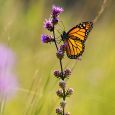





Comments